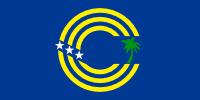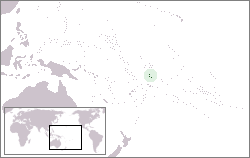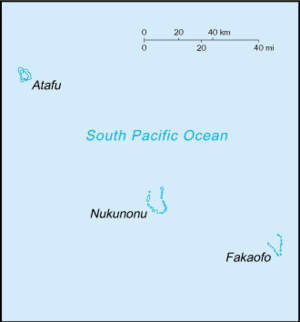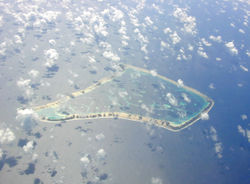Tokelau
2007 Schools Wikipedia Selection. Related subjects: Geography of Oceania (Australasia)
|
||||||||||||||||||||||||||||||||||||||||
Tokelau is a non-self-governing colonial territory of New Zealand that comprises a group of three tropical coral atolls in the South Pacific Ocean. The islands are occasionally referred to by Westerners by an older colonial name, The Union Islands. Until 1976, the official name was Tokelau Islands. The United Nations Committee on Decolonization includes Tokelau on the United Nations list of Non-Self-Governing Territories. It is, according to the CIA World Factbook list of countries by GDP, the poorest country in the world.
History
Tokelau was originally settled by Polynesians migrating from other island groups. The islands became a British protectorate in 1889 and then were annexed to the British colony of the Gilbert and Ellice Islands in 1916 and then transferred to New Zealand administration in 1926. By the Tokelau Act of 1948, sovereignty over Tokelau was transferred to New Zealand. Defence is also the responsibility of New Zealand. However, the Tokelauans are drafting a constitution and developing institutions and patterns of self-government as Tokelau moves towards free association with New Zealand, similarly to Niue and the Cook Islands.
Politics
The head of state is Queen Elizabeth II, who is represented by Administrator David Payton. The head of government is Pio Tuia, who presides over the Council of Faipule, consisting of three elected leaders, one from each atoll, which functions as a cabinet. The monarch is hereditary, the administrator appointed by the Minister of Foreign Affairs and Trade in New Zealand, and the head of government is chosen from the Council of Faipule for a one-year term.
The Tokelau Amendment Act of 1996 confers legislative power on the General Fono, a unicameral body of 45 seats. Each atoll's Council of Elders or Taupulega chooses 15 representatives to serve three-year terms.
On November 11, 2004, Tokelau and New Zealand took steps to formulate a treaty that would turn Tokelau from a non-self-governing territory to a self-governing state in free association with New Zealand. Besides the treaty, a UN-sponsored referendum took place, with the three islands voting on successive days starting February 13, 2006. (Tokelauans based in Apia, Samoa voted on February 11.) . Out of 581 votes cast, 349 were for Free Association, being short of the two-thirds majority required for the measure to pass. The referendum was profiled (somewhat light-heartedly) in the May, 1, 2006 issue of The New Yorker magazine. A repeat referendum is planned for November 2007.
Geography
Tokelau comprises three atolls in the South Pacific Ocean between 171° and 173° W longitude and 8° and 10° S latitude, approximately midway between Hawaiʻi and New Zealand. They lie about 500 km north of Samoa.
The islands are Atafu (at one time known as the Duke of York Group), Nukunonu (also the Duke of Clarence Group), and Fakaofo (once Bowditch Island). Between them they comprise a land area of 10.8 km². They have no ports or harbours. Tokelau lies in the Pacific typhoon belt.
Territorial claim
A fourth island that is culturally, historically and geographically - but not politically - part of the Tokelau chain is Swains Island (Olohega), under United States control since about 1900 and administered as part of American Samoa since 1935. The island was claimed by the United States pursuant to the Guano Islands Act. In the draft constitution of Tokelau subject to the Tokelauan self-determination referendum in 2006, Olohega is again claimed as part of Tokelau.
Economy
Tokelau is not a wealthy community, with a purchasing power of about US$1,000(€814) per capita. The government is almost entirely dependent on subsidies from New Zealand. It has annual revenues of about less than US$500,000 (€410,000) against expenditures of some US$2.8 million (€2.3 million). The deficit is made up by aid from New Zealand. Tokelau exports around US$100,000(€80,000) of stamps, copra and handicrafts (woven and carved) and imports over US$300,000(€245,000) of foodstuffs, building materials and fuel to and from New Zealand. New Zealand also pays directly for the cost of medical and education services.
A large number of Tokelauan people live in New Zealand and support their families in Tokelau by remittances.
Local industries include small-scale enterprises for copra production, wood work, plaited craft goods, stamps, coins, and fishing. Agriculture and livestock produces coconuts, copra, breadfruit, papayas, bananas, pigs, poultry and few goats.
Demographics
Tokelau has fewer than 1,500 Polynesian inhabitants in three villages who speak Tokelauan and English. Their isolation and lack of resources greatly limits economic development and confines agriculture to the subsistence level. The very limited natural resources and overcrowding are contributing to emigration to New Zealand, resulting in a population decline of about 0.9% per year. Depletion of tuna has made fishing for food more difficult.
On the island of Atafu, all inhabitants are members of the Congregational Christian Church of Samoa. On Nukunonu all are Roman Catholic. On Fakaofo, both denominations are present with the Congregational Christian Church predominant. The total proportions are: Congregational Christian Church 70%, Roman Catholic 28%, other 2%.
Internet domain names
Tokelau has an Internet country code top-level domain ( ccTLD), .tk, and attempts to make money for the island by selling domain names. However, to gain publicity, Tokelau gives most domain names under its authority away to anyone for free. Free domains are pointed to Tokelau nameservers that redirect HTTP traffic via HTML frames to a specified web page and redirects 5 email addresses to external addresses. Only paid domains get the option of using a different nameserver (enabling more services and disabling the web/email forwarding).




